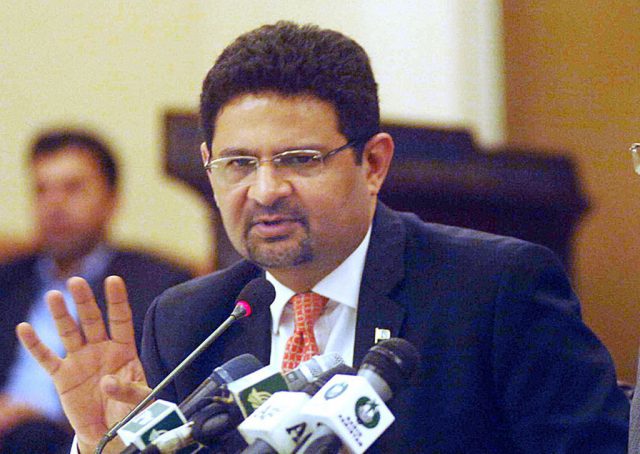ISLAMABAD: Adviser to the Prime Minister on Finance Miftah Ismail, Thursday, said that Pakistan’s net debt has increased from 60.2 per cent to 61.4 per cent while liquid forex reserves have declined by $4.5 billion.
Miftah Ismail said net debt has increased from 60.2 per cent to 61.4 per cent, while the external debt has decreased from 21.4 per cent of Gross Domestic Product (GDP) to 20.5 per cent of the GDP during FY17-18. He said the government has had to take on external debt to finish projects that the previous governments had taken on and not completed.
On Thursday, the adviser to the Prime Minister on Finance along with the Minister for Planning and Development Ahsan Iqbal revealed the economy’s performance over the fiscal year 2017-18 (FY17-18), a day before the announcement of federal budget FY 2018-19.
According to the Pakistan Economic Survey (PES), the total public debt stood at Rs22.82 trillion by the end of December 2017 and it recorded an increase of Rs1.4 trillion during the first six months of the current fiscal year.
“With the current account deficit widening and not being fully offset by financial inflows, the country’s total liquid forex reserves fell by $4.5 billion during July-March FY17-18,” the PES said.
“Pakistan’s current account deficit contracted by 9.2 per cent on a month-on-month basis in March 2018 and reached $1.16 billion compared to $1.28 billion in February 2018. However, the current account deficit widened by 50.5 per cent and reached $12.03 billion (3.8 per cent of GDP) during July-March FY17-18,” according to the PES.
The PES also said that this was mainly due to 20.7 per cent widening in the trade deficit, amounting to $22.3 billion. The widening of trade deficit is mainly due to a surge in the import bill by 16.6 per cent, reaching $40.6 billion.
About fiscal position, PES said that total revenues grew by 19.8 per cent to reach Rs2.38 trillion (6.9 per cent of the GDP) during July-December, FY17-18 against Rs1.99 trillion (6.2 per cent of the GDP) in the same period last fiscal year.
“The impressive performance both in tax and non-tax revenues is attributed to a significant rise in total revenues. During the first nine months of the current fiscal year, the Federal Bureau of Revenue has been able to collect around Rs2.63 trillion against Rs2.27 trillion during the same period of FY16-17, posting growth of 15.8 per cent,” according to the survey.
“Total expenditure increased by 14 per cent during July-December, FY17-18 and stood at Rs3.18 trillion (9.2 per cent of GDP) against Rs2.79 trillion (8.7 per cent of GDP) in the same period of FY16-17. Within total expenditure, development spending (excluding net lending) increased sharply and were recorded at 23.4 per cent to reach Rs613.8 billion during July-December FY17-18 as compared to Rs497.4 billion in the comparable period of FY16-17,” the PES said.
The fiscal deficit in the first six months of FY17-18 was restricted to 2.3 per cent of the GDP compared to 2.5 per cent during the corresponding period last year due to strong growth in revenues relative to expenditures, according to the PES 17-18.
Speaking on the occasion, Minister for Planning and Development Ahsan Iqbal said the current fiscal year has seen continued exports growth in all nine months as the exports increased by 12 per cent while imports have slowed down to 16.6 per cent as compared to 48 per cent at the start of the current financial year.
The PES said that exports from July-March in FY17-18 had reached $17.1 billion, compared to $15.1 billion in the corresponding period last year, registering 13.1 per cent growth.
Imports grew 15.7 per cent during the same period, rising from $38.37 billion in FY16-17 to $44.38 billion this year, registering an increase of $6.01 billion in absolute terms, the PES said.
“To slow down imports, an additional regulatory duty was imposed to curtail the inflated imports,” the document said.
The balance of payments remained stressed due to rising imports of capital equipment and fuel this fiscal year, while a recovery in global oil prices “also played a role in pushing up the import bill”, the PES said.
The growth in export earnings and remittances was insufficient to overcome the current account deficit, it said.
Remittances registered significant growth of 3.6 per cent during in FY17-18 so far, against a decline of 2 per cent last year, reaching $14.6 billion in the first nine months of the current fiscal year, compared to $14.4 billion over the same period last year, according to the PES.
“The trend will continue in coming months and it is expected that the target of $20.6 billion will be achieved,” the PES said.




